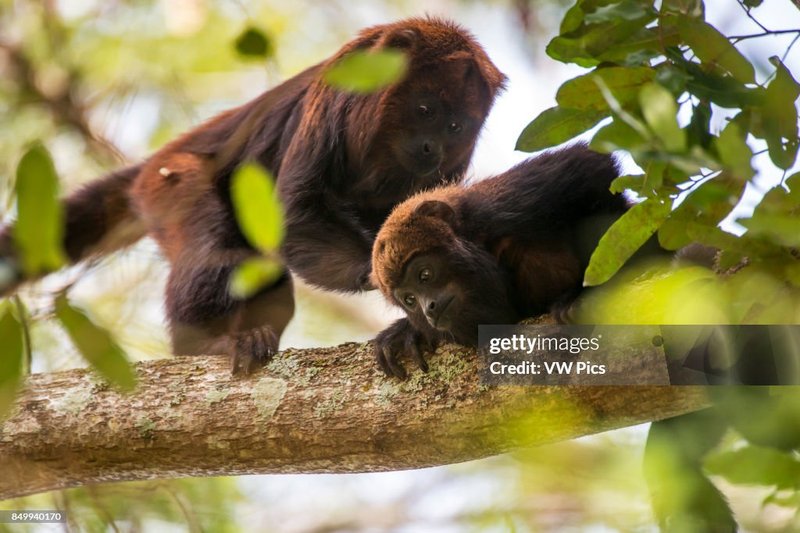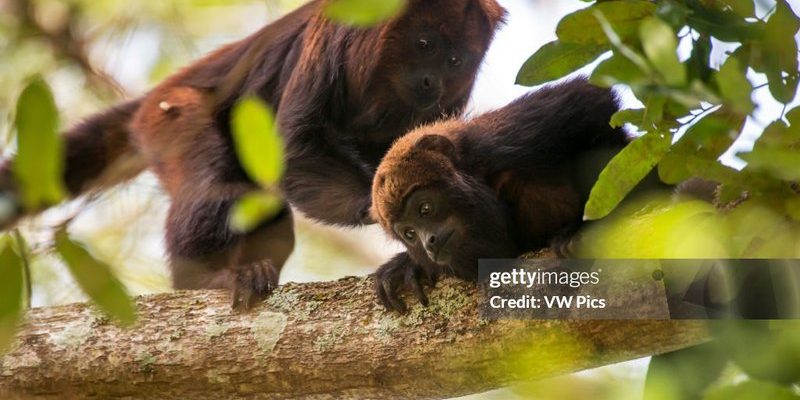
You see, howler monkeys can be both captivating and a bit intimidating. They live high in the canopy and are best known for their striking vocalizations, which can be heard up to three miles away. But like any wild animal, they deserve respect and caution. So, let’s dive into what you should do if you encounter a guariba out there in their natural habitat.
Understanding Guaribas: An Overview
Getting to know the guariba, or howler monkey, is key to having a safe and respectful encounter. These monkeys are known for their impressive size, with some species weighing around 20 pounds. They have long tails that help them swing effortlessly from branch to branch. Their striking black or brown fur and expressive faces make them a favorite among wildlife watchers.
Howler monkeys are social animals, often seen in groups. They’re herbivores, munching on leaves, fruits, and flowers. What’s more, they are diurnal, meaning they’re active during the day, which is when you’re likely to spot them. But what truly sets them apart is their vocalization. The howling serves as a means to communicate with their troop, establish territory, and warn off potential threats. If you hear that iconic howl, you’re in the presence of a guariba family!
Stay Calm and Assess the Situation
If you find yourself face-to-face with a howler monkey, the first thing to remember is to stay calm. Animals can sense fear, and acting anxious can lead to unnecessary stress for both you and the monkey. Take a moment to assess the situation.
Are you in a group, or are you alone? If you’re with others, it’s best to stay close together. Guaribas are generally not aggressive unless they feel threatened, so showing that you mean no harm is crucial. It’s also wise to observe the monkey’s behavior. Is it foraging for food? Or is it vocalizing? Watching from a distance can be fascinating and allows the monkey to go about its business without interference.
Do Not Approach Too Closely
When encountering a guariba, it’s important to maintain a respectful distance. Approaching too closely can make the animal feel cornered or threatened, leading to defensive behavior. Wild animals have their own territory, and stepping into it can cause stress for them.
Take a few steps back and create space. Use your binoculars to get a better view of the monkey without intruding. You might be tempted to snap a few pictures—but keep your distance! This isn’t just about your safety; it’s about respecting their natural behavior.
Here’s a quick tip: If they seem to be watching you curiously, it’s a good sign they aren’t threatened. But if they start howling or showing their teeth, it’s best to move away slowly and quietly.
Observe and Enjoy the Moment
Now that you’re at a safe distance, it’s time to observe and appreciate these remarkable creatures. Howler monkeys often engage in playful behavior, swinging and climbing among the branches. This can be both entertaining and educational, providing insight into their social dynamics.
Consider this a rare opportunity to witness wildlife in action. You might even get to hear their howls up close! Their calls vary depending on the species and can range from deep growls to loud screams. Did you know that male howler monkeys have larger throat sacs that amplify their calls? If you’re lucky, you might get to hear their impressive choruses as they communicate with one another.
Taking the time to enjoy the moment helps you connect with nature on a deeper level while also respecting the wild animal before you.
Know How to React if Provoked
While howler monkeys are generally not aggressive, there are times when they might feel threatened. If a guariba shows signs of aggression, such as loud vocalizations or charging your direction, it’s important to know how to react.
The first rule is to never run away. This can trigger a chase response. Instead, back away slowly, keeping your body facing the monkey. Avoid direct eye contact, as this can be perceived as a challenge. If the monkey continues to approach, make yourself appear larger by raising your arms or backpack. This might help deter their advance.
If you find that a howler is being particularly aggressive, it’s best to leave the area altogether. Even a loud yell or shout can sometimes escalate a situation; it’s better to walk away calmly.
Leaving the Area Respectfully
Once you’ve had your encounter, it’s important to leave the area respectfully. Avoid making loud noises or sudden movements as you back away. You want to ensure that you leave without disturbing their natural behavior.
If you’re in a group, communicate quietly with each other as you exit. Make sure to take any trash or belongings with you, leaving the space as you found it—if not better. Wildlife thrives best in clean, undisturbed environments, and your actions can help preserve that.
Consider this: The next person who walks through might want to experience the same beauty and wonder you just did. It’s our responsibility to respect and protect these wild habitats so they can continue to inspire awe for generations to come.
Final Thoughts on Encountering Guaribas
Encountering a guariba in the wild can be a thrilling experience, but it’s crucial to approach these moments with respect and caution. By staying calm, keeping your distance, and observing their natural behavior, you can appreciate these incredible animals safely.
Remember, they’re living their lives just as you are, and your encounter should feel mutually respectful. So next time you hear that deep, soulful howl echoing through the trees, you’ll be prepared—ready to enjoy the beauty of nature in one of its most vibrant forms. Whether you’re a nature lover or just someone looking for a new adventure, experiencing a howler monkey in the wild is truly unforgettable.

